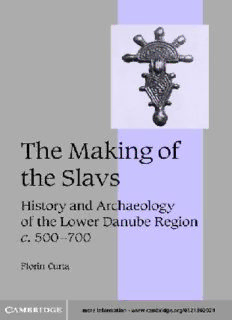
The Making of the Slavs: History and Archaeology of the Lower Danube Region, c.500-700 PDF
Preview The Making of the Slavs: History and Archaeology of the Lower Danube Region, c.500-700
This page intentionally left blank The Making of the Slavs This book offers a new approach to the problem of Slavic ethnicity in south- eastern Europe between c. and c. , from the perspective of current anthropological theories. The conceptual emphasis here is on the relation between material culture and ethnicity. The author demonstrates that the history of the Sclavenes and the Antes begins only at around . He also points to the significance of the archaeological evidence, which suggests that specific artifacts may have been used as identity markers. This evidence also indicates the role of local leaders in building group boundaries and in leading successful raids across the Danube. The names of many powerful leaders appear in written sources, some being styled “kings.”Because ofthese military and political developments, Byzantine authors began employing names such as Sclavenes and Antes in order to make sense of the process of group identification that was taking place north of the Danube frontier. Slavic ethnicity is therefore shown to be a Byzantine invention. is Assistant Professor ofMedieval History, University ofFlorida Cambridge Studies in Medieval Life and Thought THE MAKING OF THE SLAVS Cambridge Studies in Medieval Life and Thought Fourth Series General Editor: . . Research Professor of Medieval History, University of Sheffield Advisory Editors: Reader in Medieval English History, University of Cambridge, and Fellow of New Hall Professor of Medieval History, University of Cambridge, and Fellow of Newnham College The series Cambridge Studies in Medieval Life and Thought was inaugurated by G. G. Coulton in ; Professor D. E. Luscombe now acts as General Editor of the Fourth Series, with Dr Christine Carpenter and Professor Rosamond McKitterick as Advisory Editors. The series brings together outstanding work by medieval scholars over a wide range of human endeavour extending from political economy to the history of ideas. For a list of titles in the series, see end of book. THE MAKING OF THE SLAVS History and Archaeology of the Lower Danube Region, c. – FLORIN CURTA The Pitt Building, Trumpington Street, Cambridge, United Kingdom The Edinburgh Building, Cambridge CB2 2RU, UK 40 West 20th Street, New York, NY 10011-4211, USA 477 Williamstown Road, Port Melbourne, VIC 3207, Australia Ruiz de Alarcón 13, 28014 Madrid, Spain Dock House, The Waterfront, Cape Town 8001, South Africa http://www.cambridge.org ©Florin Curta 2004 First published in printed format 2001 ISBN 0-511-03248-X eBook(Adobe Reader) ISBN 0-521-80202-4 hardback CONTENTS List of figures page ix List of tables xiii Acknowledgments xiv List of abbreviations xv Introduction Slavic ethnicity and the ethnie of the Slavs: concepts and approaches Sources for the history of the early Slavs (c. –) The Slavs in early medieval sources (c. –) The Balkans and the Danube limes during the sixth and seventh centuries Barbarians on the sixth-century Danube frontier: an archaeological survey Elites and group identity north of the Danube frontier: the archaeological evidence “Kings”and “ democracy”: power in early Slavic society Conclusion: the making of the Slavs Appendix A Appendix B References Index vii
Description: